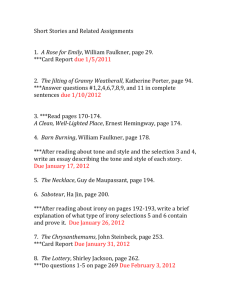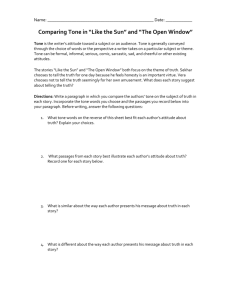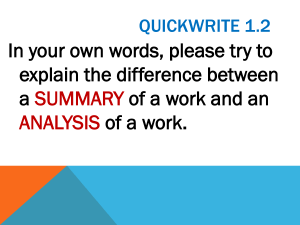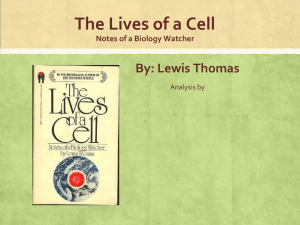273ToneandStyleSpring.doc
advertisement
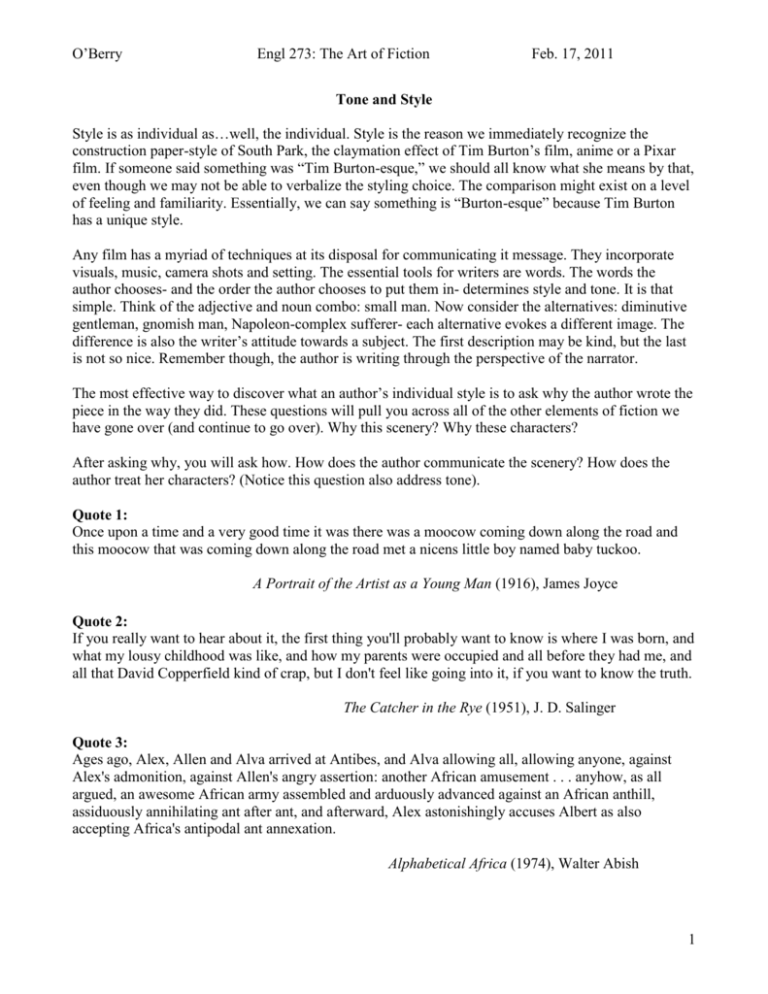
O’Berry Engl 273: The Art of Fiction Feb. 17, 2011 Tone and Style Style is as individual as…well, the individual. Style is the reason we immediately recognize the construction paper-style of South Park, the claymation effect of Tim Burton’s film, anime or a Pixar film. If someone said something was “Tim Burton-esque,” we should all know what she means by that, even though we may not be able to verbalize the styling choice. The comparison might exist on a level of feeling and familiarity. Essentially, we can say something is “Burton-esque” because Tim Burton has a unique style. Any film has a myriad of techniques at its disposal for communicating it message. They incorporate visuals, music, camera shots and setting. The essential tools for writers are words. The words the author chooses- and the order the author chooses to put them in- determines style and tone. It is that simple. Think of the adjective and noun combo: small man. Now consider the alternatives: diminutive gentleman, gnomish man, Napoleon-complex sufferer- each alternative evokes a different image. The difference is also the writer’s attitude towards a subject. The first description may be kind, but the last is not so nice. Remember though, the author is writing through the perspective of the narrator. The most effective way to discover what an author’s individual style is to ask why the author wrote the piece in the way they did. These questions will pull you across all of the other elements of fiction we have gone over (and continue to go over). Why this scenery? Why these characters? After asking why, you will ask how. How does the author communicate the scenery? How does the author treat her characters? (Notice this question also address tone). Quote 1: Once upon a time and a very good time it was there was a moocow coming down along the road and this moocow that was coming down along the road met a nicens little boy named baby tuckoo. A Portrait of the Artist as a Young Man (1916), James Joyce Quote 2: If you really want to hear about it, the first thing you'll probably want to know is where I was born, and what my lousy childhood was like, and how my parents were occupied and all before they had me, and all that David Copperfield kind of crap, but I don't feel like going into it, if you want to know the truth. The Catcher in the Rye (1951), J. D. Salinger Quote 3: Ages ago, Alex, Allen and Alva arrived at Antibes, and Alva allowing all, allowing anyone, against Alex's admonition, against Allen's angry assertion: another African amusement . . . anyhow, as all argued, an awesome African army assembled and arduously advanced against an African anthill, assiduously annihilating ant after ant, and afterward, Alex astonishingly accuses Albert as also accepting Africa's antipodal ant annexation. Alphabetical Africa (1974), Walter Abish 1 O’Berry Engl 273: The Art of Fiction Feb. 17, 2011 Quote 4: It was a queer, sultry summer, the summer they electrocuted the Rosenbergs, and I didn't know what I was doing in New York. Sylvia Plath, The Bell Jar (1963) Quote 5: You better not never tell nobody but God. - Alice Walker, The Color Purple (1982) Quote 6: It was a pleasure to burn. - Ray Bradbury, Fahrenheit 451 (1953) Quote 7: Money . . . in a voice that rustled. - William Gaddis, J R (1975) Style & Tone Terminology: [This list is infinite. Add to it.] Draconian: Juvenalian Satire: Axiomatic: Menippean Satire: Macabre: Verbose: Morose: Satiric: Parsimonious: Dark: Psychedelic: Precocious: Wistful: Nonsensical: Terse: Childish: Minimalism/Minimalistic: Playful: Realism/Realistic: Sexy: Cosmic irony: Teasing: Dramatic irony: Colloquial: Comedic irony: Laconic: Satire: Didactic: 2 O’Berry Engl 273: The Art of Fiction Feb. 17, 2011 Faulkner’s “Barn Burning” 1. Earlier we noted the difference between saying “small man” versus “Napoleon-complex sufferer”. Look back over the text and find a couple of examples where the author uses distinct word choices, what were the author’s other alternatives? a. What does the author’s choice suggest about what they are describing? 2. Identify the writer’s style (note the author’s diction and syntax). a. What does the style convey about the story as a whole? Does it relate to any themes of the story? 3. Tone: look back at the list of adjectives that describe tone. Choose one or two from the list (or not from the list) that describes the story’s tone. How did you decide on this tone? What words or images that procured this tone (list words or images)? 3 O’Berry Engl 273: The Art of Fiction Feb. 17, 2011 Hemingway’s “A Clean, Well-Lighted Place” 1. Earlier we noted the difference between saying “small man” versus “Napoleon-complex sufferer”. Look back over the text and find a couple of examples where the author uses distinct word choices, what were the author’s other alternatives? a. What does the author’s choice suggest about what they are describing? 2. Identify the writer’s style (note the author’s diction and syntax). a. What does the style convey about the story as a whole? Does it relate to any themes of the story? 3. Tone: look back at the list of adjectives that describe tone. Choose one or two from the list (or not from the list) that describes the story’s tone. How did you decide on this tone? What words or images that procured this tone (list words or images)? 4

